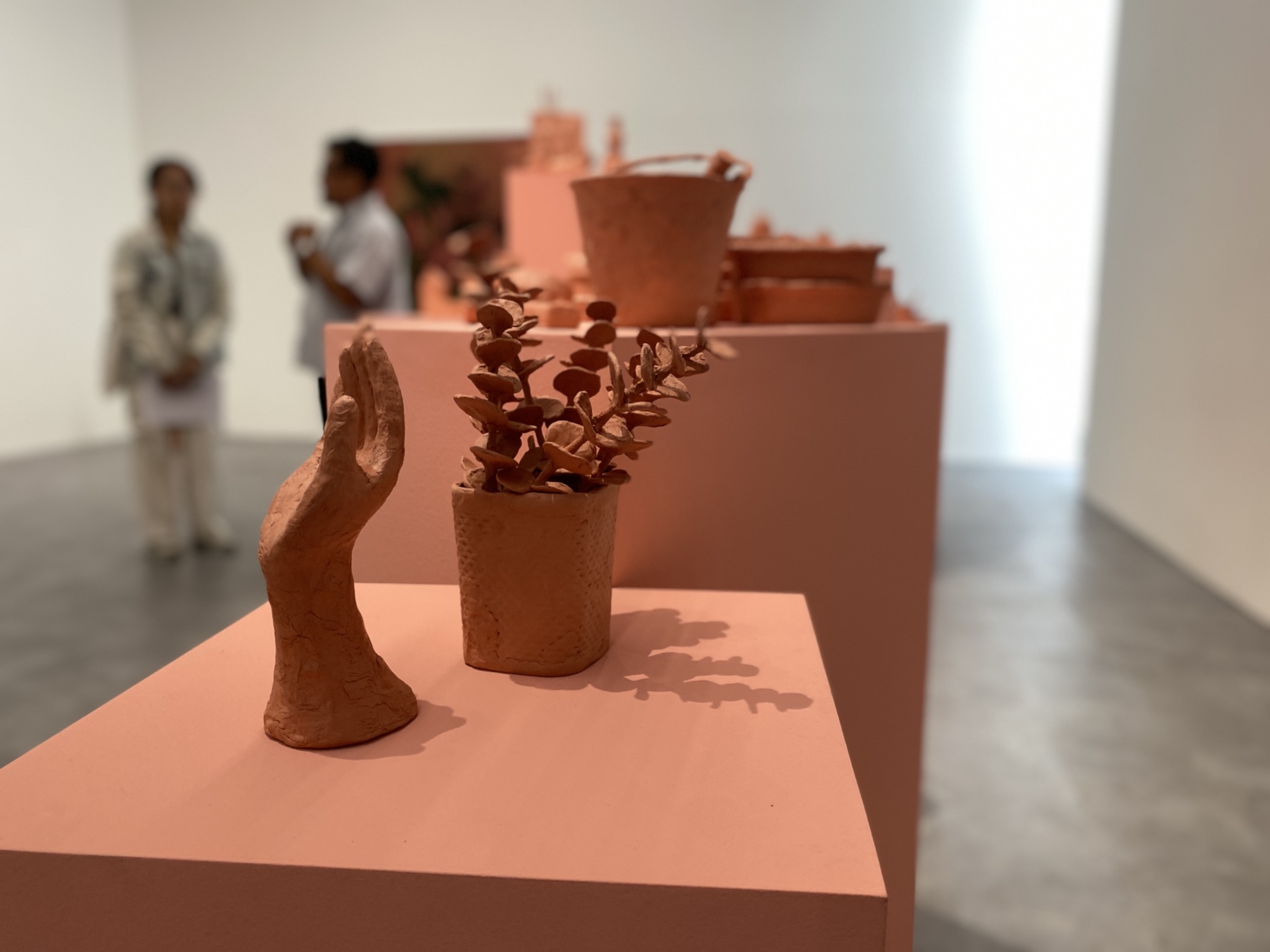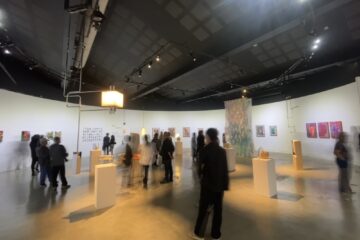This exhibition celebrates the simple, often overlooked aspects of human life. In that stillness and simplicity, the most honest and meaningful presence of life often resides.
Wedhar Riyadi presents his solo exhibition, In Between Stillness, at Ara Contemporary, Jakarta, from August 16 to September 14, 2025. The exhibition showcases his latest series, Tabletop Diaries, a collection of still-life paintings that honor the mundane yet profound elements of human existence. The inspiration for these works emerged from Wedhar’s quiet observations during the isolation of the COVID-19 pandemic.
Upon entering the gallery, your attention may immediately be drawn to a row of monochromatic pink objects neatly arranged on a table at the center. It’s natural to assume these are the exhibition’s main works. However, a glance at the catalog reveals that the twelve paintings are the official exhibits. The objects on the table are “merely” accents, though their presence is hard to ignore.
These clay replicas, inspired by everyday domestic items familiar to Wedhar during the pandemic, are intentionally crafted without details like labels or distinct characteristics. Their simplified, unadorned forms invite personal interpretation. Like a spiritual principle that finds meaning in silence and emptiness, these objects entrust their significance to the viewer.
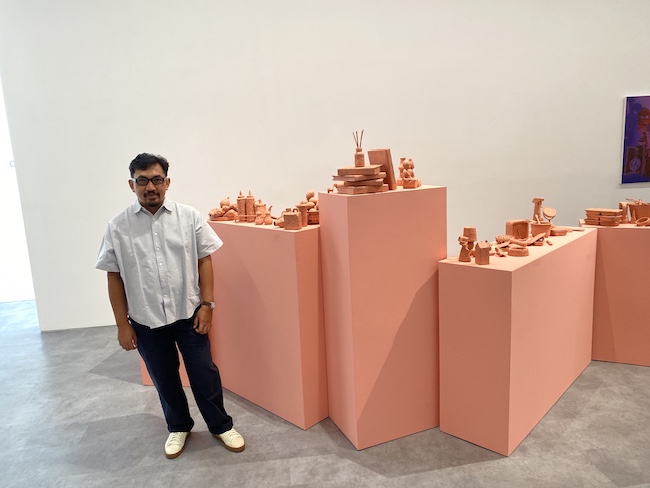
Are they merely supplementary? Certainly not. Traditional still-life paintings often reveal life’s transience through objects like bitten fruit or wilting flowers. In Wedhar Riyadi’s works, the “presence of humanity” is felt through fingerprints on the pinched clay surfaces. Scratches, wear, stains, and patina become mute historical records, evidence that these objects were created and touched.
Clay, an ancient symbol of both creation and the end of life, reminds us of existence’s cyclical nature. Thus, though not listed in the catalog, these clay replicas are the heart that animates every painting in the gallery.
Let’s delve deeper into the exhibition, starting with the opening work: Amber Grid. This painting presents a serene composition of two chairs and a small table, their material texture rough and tangible, accompanied by a potted plant on the right. Warm light, gradating from amber to yellow, flows from above, casting long shadows that lend a dramatic dimension to the scene. The dominance of reddish-brown on the walls, paired with a glossy floor, creates an intimate, warm atmosphere, like a private space whispering an invitation to reflect.
As the opening piece of In Between Stillness, Amber Grid is designed to make a striking first impression. The domestic objects—chairs, table, plant—are familiar fragments of daily life. Yet, Wedhar elevates them beyond simplicity through a theatrical interplay of light and shadow that is both evocative and introspective.
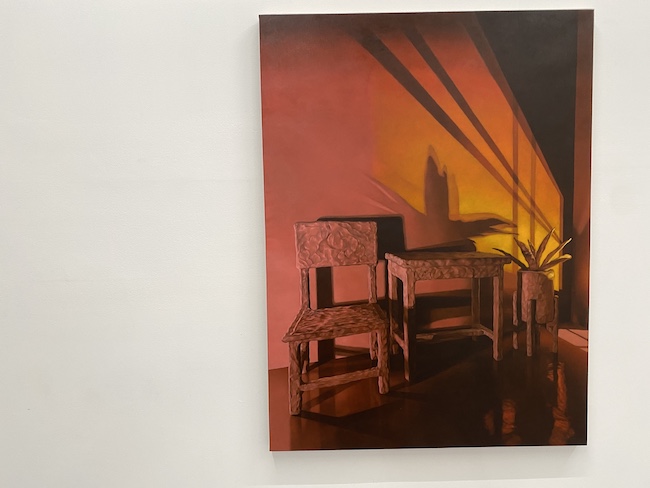
This painting serves as a conceptual “veranda.” It is a transitional space inviting visitors to pause, take a breath, and absorb the stillness before venturing further into the stories of the other still-life paintings. Its quiet yet meaningful atmosphere is a gentle call to contemplate space, time, and the hidden presence within the rhythm of daily life we often overlook.
Its quiet yet meaningful atmosphere is a gentle call to contemplate space, time, and the hidden presence within the rhythm of daily life we often overlook.
Moving on from Amber Grid, we encounter Loro Blonyo. This painting features two human figures that instantly evoke the Javanese loro blonyo, a traditional symbol often adorning homes. These figures are placed amid potted plants, framed by dramatic leaf shadows. A rich, deep red background, enhanced by light reflecting off the statues’ surfaces, creates an atmosphere that is simultaneously sacred, profound, and steeped in mystery.
The work’s meaning is deeply tied to the Javanese philosophy of loro blonyo (meaning “two united”). Typically depicting a traditionally dressed husband and wife, these figures embody harmony, loyalty, and domestic happiness. Wedhar Riyadi reimagines this ancient symbol in a contemporary context. The placement of the statues among plants is not merely compositional; it can be read as a metaphor for growth and flourishing life.
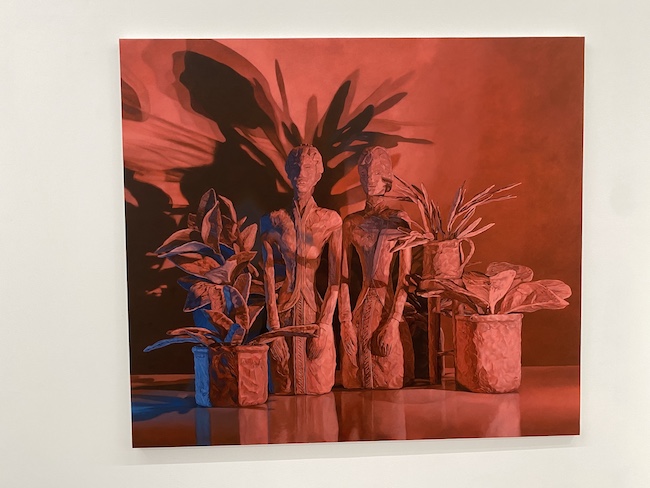
The intense red palette—symbolizing passion, love, or vital energy—breathes a modern spirit into the traditional narrative. Through an artistic interplay of light and shadow, Wedhar not only showcases aesthetic beauty but also invites reflection on the relevance of these cultural values in today’s world, questioning their endurance amid changing times.
The journey continues with Recess, a painting that crystallizes the reality of a domestic workspace during the pandemic. On its surface lie a desk lamp with a coiling cord like taut nerves, a towering stack of books, a coffee mug, a pair of glasses, and a glimmer of hope from a small potted plant. The rich surface texture and sharp shadows bring these objects to life, hinting at traces of intense use and long working hours.
The title Recess, meaning a break or pause, carries deep irony. This desk, the gravitational center of life during work-from-home, becomes a stage for the tension between productivity and exhaustion. The lamp and books stand as monuments to work’s demands, while the mug and small plant subtly signify resistance—an attempt to weave comfort or a moment of recharge into the grind.
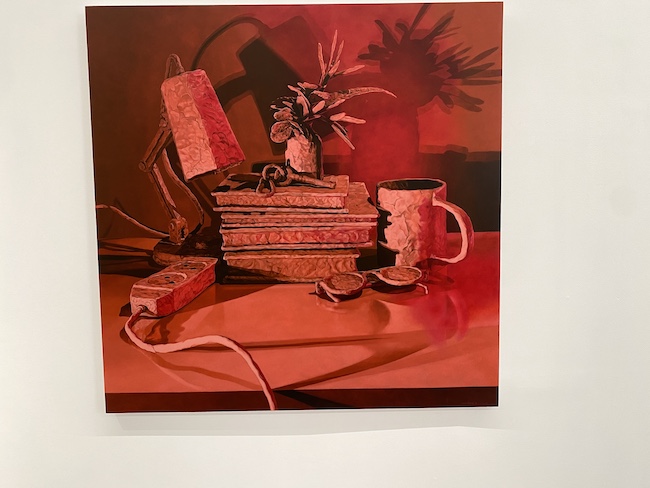
The dominant red palette, consistent with earlier works, can be interpreted in two ways. It represents the tension and psychological pressure of isolation, yet also the warmth and sanctuary of private space. Recess thus serves as a reflective mirror of our struggle to find balance between work’s demands and the urgent need to breathe amid extraordinary circumstances that confined the world.
The dominant red palette, consistent with earlier works, can be interpreted in two ways. It represents the tension and psychological pressure of isolation, yet also the warmth and sanctuary of private space.
While the Tabletop Diaries series generally focuses on intimate domestic objects, the work on the lower floor of the gallery (Focus Gallery), titled The Light That Remains, presents a different, poignant panorama. This painting moves beyond the still life of a desk to a symbolic landscape rich with narrative. A fragile yellow wooden bridge stretches across the center, flanked by old reddish-brown buildings and sprawling wild vegetation. A barren tree with branches clawing at the sky adds a melancholic tone, while the dark background contrasts with soft, warm light reflecting off the bridge and foliage, like a resilient beacon piercing a dark mist.
This work is a gateway to memory and literature. Wedhar Riyadi reveals that its primary inspiration comes from Kuntowijoyo’s novel Kereta Api yang Berangkat Pagi Hari, specifically a passage depicting a father faithfully awaiting his child’s return, lantern in hand, glowing through the night. The fragile bridge in the painting is a bitter metaphor: a longed-for path home, yet a reflection of uncertainty and time eroding hope.
The ruins of buildings and wild vegetation not only create a miniature post-apocalyptic scene but may symbolize fading memories or life stubbornly growing amid the debris of departure. The soft light referenced in the title, though not physically depicting a lantern, embodies its essence: a symbol of hope, a father’s love, and an enduring spirit that persists despite grim realities. The lantern glows not in the father’s hand within the painting but in his heart, its light seeping through Wedhar’s brushstrokes.
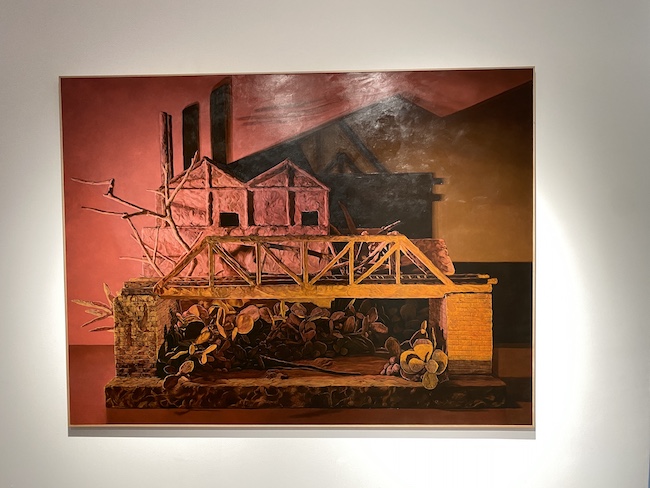
Within the context of In Between Stillness, The Light That Remains is a sublime conclusion. It shifts the focus from the still life of inanimate objects to the still life of the human soul. Through rich symbolism and a dramatic, contrasting palette, Wedhar not only encapsulates the themes of patience and nostalgia from Kuntowijoyo’s novel but also touches on the universality of human experience. This work stands as a silent testament that within the stillness and “silence” Wedhar observed during the pandemic lies a vast inner landscape of longing and an ever-burning light.
At the end of the journey in the Focus Gallery, after exploring still-life paintings that whisper stories of ordinary objects, visitors encounter a space. There, waiting in the same stillness, stand the three-dimensional clay replicas of the figures from Amber Grid—the opening work that welcomed us into the exhibition.
Their presence in this space feels like both a finale and a new beginning. Wedhar Riyadi, once again, invites us into his “veranda.” This empty space itself becomes the final metaphor—a space of pause, where we are invited to stop, truly stop, and reflect on the journey we’ve traversed.
This intimate, captured space prompts us to think: Amid the busyness that often consumes us, can we find our own “veranda” moment? Can we see the magic in the morning coffee mug, the shadows falling on an afternoon wall, or the small plant that keeps growing? Wedhar Riyadi reminds us that in stillness and simplicity, the most honest and meaningful presence of life often resides.
- Cover image: Hidayat Adhiningrat
- Dancing on the Grave of Severed Memories - September 30, 2025
- The Magic of Objects in Stillness - September 30, 2025
- The Storytelling Soil - September 30, 2025

